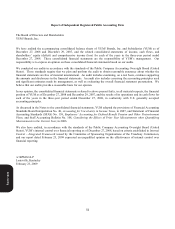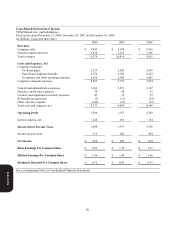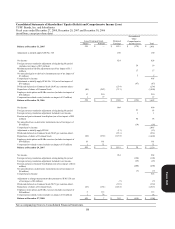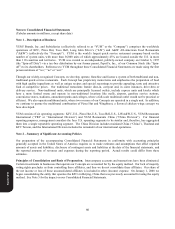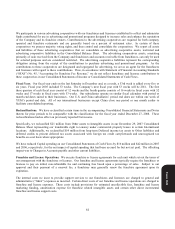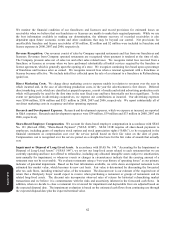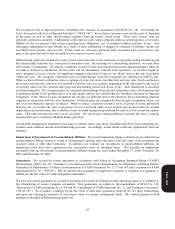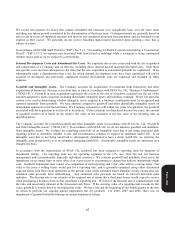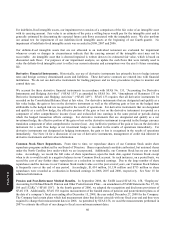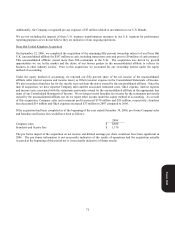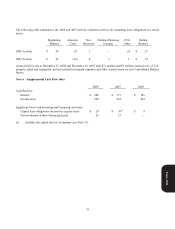Pizza Hut 2008 Annual Report Download - page 186
Download and view the complete annual report
Please find page 186 of the 2008 Pizza Hut annual report below. You can navigate through the pages in the report by either clicking on the pages listed below, or by using the keyword search tool below to find specific information within the annual report.
64
Income Taxes. We account for income taxes in accordance with SFAS No. 109, “Accounting for Income Taxes” (“SFAS
109”). Under SFAS 109, we record deferred tax assets and liabilities for the future tax consequences attributable to
temporary differences between the financial statement carrying amounts of existing assets and liabilities and their
respective tax bases and operating loss and tax credit carryforwards. Deferred tax assets and liabilities are measured using
enacted tax rates expected to apply to taxable income in the years in which those differences are expected to be recovered
or settled. The effect on deferred tax assets and liabilities of a change in tax rates is recognized in income in the period
that includes the enactment date. In addition, a valuation allowance is recorded to reduce the carrying amount of deferred
tax assets if it is more likely than not all or a portion of the asset will not be realized.
Effective December 31, 2006, we adopted FASB Interpretation No. 48, “Accounting for Uncertainty in Income Taxes”, an
interpretation of SFAS 109 (“FIN 48”). FIN 48 requires that a position taken or expected to be taken in a tax return be
recognized in the financial statements when it is more likely than not (i.e. a likelihood of more than fifty percent) that the
position would be sustained upon examination by tax authorities. A recognized tax position is then measured at the
largest amount of benefit that is greater than fifty percent likely of being realized upon settlement. FIN 48 also requires
that changes in judgment that result in subsequent recognition, derecognition or change in a measurement of a tax position
taken in a prior annual period (including any related interest and penalties) be recognized as a discrete item in the interim
period in which the change occurs. Prior to adopting FIN 48, we provided reserves for potential exposures when we
considered it probable that a taxing authority may take a sustainable position on a matter contrary to our position and
recorded any changes in judgment thereon as a component of our annual effective rate.
The Company recognizes interest and penalties accrued related to unrecognized tax benefits as components of its income
tax provision.
See Note 19 for a further discussion of our income taxes.
Fair Value Measurements. In September 2006, the Financial Accounting Standards Board (“FASB”) issued SFAS No.
157, “Fair Value Measurements” (“SFAS 157”). SFAS 157 defines fair value, establishes a framework for measuring fair
value and enhances disclosures about fair value measurements required under other accounting pronouncements, but does
not change existing guidance as to whether or not an instrument is carried at fair value. For those financial assets and
liabilities we record or disclose at fair value, we adopted SFAS 157 at the beginning of 2008. Fair value is determined
based on the present value of expected future cash flows considering the risks involved and using discount rates
appropriate for the duration, and considers counterparty performance risk.
Cash and Cash Equivalents. Cash equivalents represent funds we have temporarily invested (with original maturities
not exceeding three months) as part of managing our day-to-day operating cash receipts and disbursements, including
short-term, highly liquid debt securities.
Inventories. We value our inventories at the lower of cost (computed on the first-in, first-out method) or market.
Property, Plant and Equipment. We state property, plant and equipment at cost less accumulated depreciation and
amortization. We calculate depreciation and amortization on a straight-line basis over the estimated useful lives of the
assets as follows: 5 to 25 years for buildings and improvements, 3 to 20 years for machinery and equipment and 3 to 7
years for capitalized software costs. As discussed above, we suspend depreciation and amortization on assets related to
restaurants that are held for sale.
Leases and Leasehold Improvements. We account for our leases in accordance with SFAS No. 13, “Accounting for
Leases” (“SFAS 13”) and other related authoritative guidance. When determining the lease term, we often include option
periods for which failure to renew the lease imposes a penalty on the Company in such an amount that a renewal appears,
at the inception of the lease, to be reasonably assured. The primary penalty to which we are subject is the economic
detriment associated with the existence of leasehold improvements which might be impaired if we choose not to continue
the use of the leased property. Leasehold improvements, which are a component of buildings and improvements
described above, are amortized over the shorter of their estimated useful lives or the lease term.
Form 10-K


